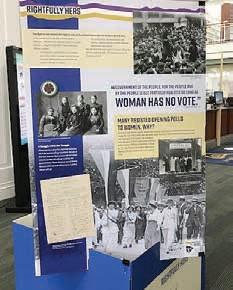
3 minute read
Alexandria Archives
The Alexandria Archives
Photo: Library of Congress

Photo by Jane Barker Above: Historical Marker near the original Occoquan Workhouse describes the suffragists’ imprisonment. At left: Women who persistently demonstrated on the sidewalk outside The White House were known as Silent Sentinels.

One Hundred Years of the Nineteenth Amendment
ALEXANDRIA CELEBRATES WOMEN’S RIGHT TO VOTE
From the Office of Historic Alexandria
When the 19th Amendment to the United States Constitution, often referred to as the “Susan B. Anthony Amendment,” was ratified August 18, 1920, it enfranchised nearly 26 million American women in time for the 1920 U.S. presidential election and put an end to nearly one hundred years of protest.
A century later, as the nation prepares to mark the centennial of a woman’s right to vote, Alexandria prepares to celebrate its suffragist heroines. As early as four decades before the American Civil War, women began to play prominent roles in temperance and religious societies and the abolitionist movement.
Sparsely populated Western states began to grant women voting rights in the 19th century but women’s enfranchisement remained far from approval on the federal level. Women’s suffrage amendments had been proposed to the U.S. Congress by 1869, followed by annual proposals between 1878 and 1920.
Southerners, mainly due to local government opposition, had been hesitant to join the pro-suffrage bandwagon, yet in 1909, Virginia women joined counterparts in other segments of the country to fight for voting rights to support reforms in child labor, education, and temperance.
Disparities within the women’s suffrage movement were nothing new. In the mid-1800s, female abolitionists had begun to document conditions of enslaved Americans as well as their own circumstances within a malecontrolled culture. But the predominantly White suffrage movement often
SUFFRAGE EXHIBITS IN TOWN
Torpedo Factory “WE VOTE! American Suffrage Art & History Exhibit”
Made possible through a partnership between The Torpedo Factory Artists’ Association and Alexandria Cerebrates Women, the exhibit open now through September 27 features “suffrage-inspired art, voting rights history, voting registration information, and a life-size ‘selfie’ suffragist backdrop,” according to a press release.
This exhibit is housed on the third floor of the Art Center in the Marian Van Landingham Gallery, Studio 311. The Torpedo Factory Art Center is located at 105 North Union Street. Visiting hours are Wednesday to Sunday, 10 a.m. to 6 p.m. To enter and exit, use the sliding doors on North Union by The Waterfront only. There is no capacity limit; however, masks are required and social distancing should be observed.
Alexandria Library “Rightfully Hers”

On display at the Kate Waller Barrett Branch, 717 Queen Street, through September 23 is an exhibit called “Rightfully Hers,” on loan from the National Archives. The exhibit contains messages discriminated against Black women shouldering the same objective.
In 1870, the 15th Amendment to the U.S. Constitution was passed. It states: “The right of citizens of the United States to vote shall not be denied or abridged by the United States or by any State on account of race, color, or previous condition of servitude.” The 15th Amendment proved stronger in concept than in practice. Many Black men were denied their right to vote by poll taxes, deceptive literacy exams, and grandfather clauses.
Of course, the 15th Amendment also excluded women. Since they had been barred from White organiza
CONTINUED ON PAGE 19
that explore the history of women’s voting rights and their meaning in the present.
There is limited capacity in the library. Those who wish to view the exhibit are asked to keep social distancing in mind. To learn more about Kate Waller Barrett and her work in the suffrage movement, make an appointment to visit the Local History/Special Collections area.










